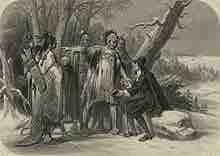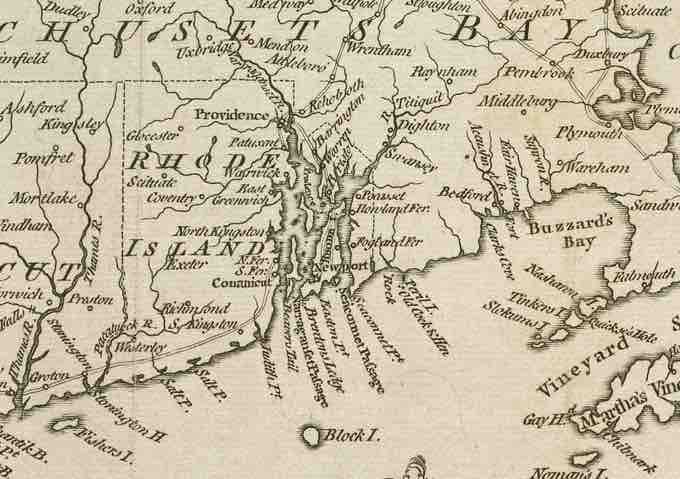Williams, Hutchinson, and Puritanism
Although many people assume Puritans escaped England to establish religious freedom, they proved to be just as intolerant as the English state church. When dissenters, including Puritan minister Roger Williams and Anne Hutchinson, challenged Governor Winthrop in Massachusetts Bay in the 1630s, they were banished. Roger Williams questioned the Puritans’ taking of American Indian land and argued for a complete separation from the Church of England, a position other Puritans in Massachusetts rejected, as well as the idea that the state could not punish individuals for their beliefs. Puritan authorities found him guilty of spreading dangerous ideas and expelled him from the colony.
Anne Hutchinson also ran afoul of Puritan authorities for her criticism of the evolving religious practices in the Massachusetts Bay Colony. In particular, she held that Puritan ministers in New England taught a shallow version of Protestantism emphasizing hierarchy and actions—a “covenant of works” rather than a “covenant of grace.” Literate Puritan women like Hutchinson presented a challenge to the male minister's authority. Her major offense was her claim of direct religious revelation, a type of spiritual experience that negated the role of ministers. Because of Hutchinson’s beliefs and her defiance of authority in the colony, especially that of Governor Winthrop, Puritan authorities tried and convicted her of holding false beliefs. In 1638, she was excommunicated and banished from the colony.
Providence Plantation
Fleeing from religious persecution, Williams went on to found Providence Plantation in 1636 on land gifted by the Narragansett and Pequot tribes. Williams agreed with his fellow settlers on an egalitarian constitution providing for majority rule in civil issues and liberty of conscience. Williams named the other islands in the Narragansett Bay after virtues: Patience Island, Prudence Island, and Hope Island. Williams wrote favorably about the American Indian peoples, contrasting their virtues with Puritan New England’s intolerance.

Engraved print depicting Roger Williams, founder of Rhode Island, meeting with the Narragansett Indians. Date first published: 1856
Narragansett Indians receiving Roger Williams
In 1637, Hutchinson also purchased land on Aquidneck Island from the American Indians, settling in Pocasset, now known as Portsmouth, Rhode Island. Later, in 1642, she sought safety among the Dutch in New Netherland. The following year, Algonquian warriors killed Hutchinson and her family. In Massachusetts, Governor Winthrop noted her death as the righteous judgment of God against a heretic.
The Founding of Rhode Island
Other neighboring settlements of Puritan refugees followed, all of which formed a loose alliance. They sought recognition together as an English colony in 1643 in response to threats to their independence. In 1644, Roger Williams secured a land patent establishing the Incorporation of Providence Plantations in the Narragansett Bay. The patent covered much of the territory that would eventually make up the state of Rhode Island. Rhode Island became a colony that sheltered dissenting Puritans from their brethren in Massachusetts.

Map of Rhode Island
A map of the colony of Rhode Island, with the adjacent parts of Connecticut and Massachusetts Bay.
The bedrock of the economy was agriculture, especially dairy farming and fishing. Lumber and shipbuilding also became major industries. The separate plantation colonies in the Narragansett Bay region were very progressive for their time, passing laws abolishing witchcraft trials, imprisonment for debt, most capital punishment, and on May 18, 1652, chattel slavery of both blacks and whites. The colonists refused to have a governor, instead setting up an elected "president" and council. Most religious groups were welcomed.
Following the 1660 restoration of royal rule in England, Rhode Island sought a Royal Charter from the new king, Charles II. Charles was then a Catholic sympathizer in staunchly Protestant England and approved the colony's promise of religious freedom. He granted the request with the Royal Charter of 1663, giving the Colony of Rhode Island and Providence Plantations an elected governor and legislature. In the following years, many persecuted groups settled in the colony.
The colony was folded into the Dominion of New England in 1686, as King James II attempted to enforce royal authority over the autonomous colonies in British North America. The dominion was extremely unpopular, and after the 1688 Glorious Revolution deposed James and brought William and Mary to the English throne, the dominion collapsed, and Rhode Island resumed its previous government.
Rhode Island was the first of the 13 colonies to renounce its allegiance to the British Crown on May 4, 1776. It was also the last of the 13 colonies to ratify the United States Constitution on May 29, 1790, once a Bill of Rights had been included.
Relations with American Indians
Although Rhode Island remained at peace with the American Indians, the relationship between the other New England colonies and the American Indians was more strained and often led to bloodshed. During King Philip's War (1675–1676), both sides regularly violated Rhode Island's neutrality. The war's largest battle occurred in Rhode Island, when a force of Massachusetts, Connecticut, and Plymouth militia invaded and destroyed the fortified Narragansett Indian village in the Great Swamp in southern Rhode Island in 1675. The Narragansett also invaded and burned down several cities in Rhode Island, including Providence, although they allowed the population to leave first.